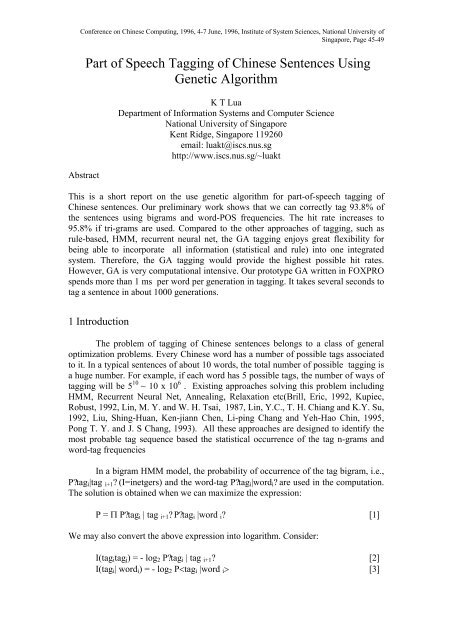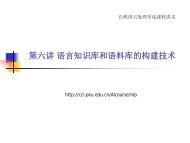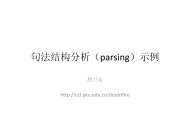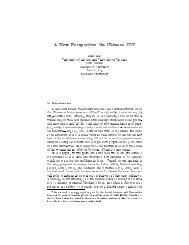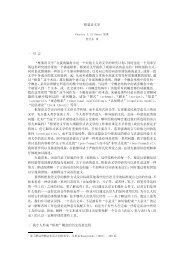Part of Speech Tagging of Chinese Corpus Using Genetic Algorithm
Part of Speech Tagging of Chinese Corpus Using Genetic Algorithm
Part of Speech Tagging of Chinese Corpus Using Genetic Algorithm
Create successful ePaper yourself
Turn your PDF publications into a flip-book with our unique Google optimized e-Paper software.
Conference on <strong>Chinese</strong> Computing, 1996, 4-7 June, 1996, Institute <strong>of</strong> System Sciences, National University <strong>of</strong><br />
Singapore, Page 45-49<br />
Abstract<br />
<strong>Part</strong> <strong>of</strong> <strong>Speech</strong> <strong>Tagging</strong> <strong>of</strong> <strong>Chinese</strong> Sentences <strong>Using</strong><br />
<strong>Genetic</strong> <strong>Algorithm</strong><br />
K T Lua<br />
Department <strong>of</strong> Information Systems and Computer Science<br />
National University <strong>of</strong> Singapore<br />
Kent Ridge, Singapore 119260<br />
email: luakt@iscs.nus.sg<br />
http://www.iscs.nus.sg/~luakt<br />
This is a short report on the use genetic algorithm for part-<strong>of</strong>-speech tagging <strong>of</strong><br />
<strong>Chinese</strong> sentences. Our preliminary work shows that we can correctly tag 93.8% <strong>of</strong><br />
the sentences using bigrams and word-POS frequencies. The hit rate increases to<br />
95.8% if tri-grams are used. Compared to the other approaches <strong>of</strong> tagging, such as<br />
rule-based, HMM, recurrent neural net, the GA tagging enjoys great flexibility for<br />
being able to incorporate all information (statistical and rule) into one integrated<br />
system. Therefore, the GA tagging would provide the highest possible hit rates.<br />
However, GA is very computational intensive. Our prototype GA written in FOXPRO<br />
spends more than 1 ms per word per generation in tagging. It takes several seconds to<br />
tag a sentence in about 1000 generations.<br />
1 Introduction<br />
The problem <strong>of</strong> tagging <strong>of</strong> <strong>Chinese</strong> sentences belongs to a class <strong>of</strong> general<br />
optimization problems. Every <strong>Chinese</strong> word has a number <strong>of</strong> possible tags associated<br />
to it. In a typical sentences <strong>of</strong> about 10 words, the total number <strong>of</strong> possible tagging is<br />
a huge number. For example, if each word has 5 possible tags, the number <strong>of</strong> ways <strong>of</strong><br />
tagging will be 5 10 ~ 10 x 10 6 . Existing approaches solving this problem including<br />
HMM, Recurrent Neural Net, Annealing, Relaxation etc(Brill, Eric, 1992, Kupiec,<br />
Robust, 1992, Lin, M. Y. and W. H. Tsai, 1987, Lin, Y.C., T. H. Chiang and K.Y. Su,<br />
1992, Liu, Shing-Huan, Ken-jiann Chen, Li-ping Chang and Yeh-Hao Chin, 1995,<br />
Pong T. Y. and J. S Chang, 1993). All these approaches are designed to identify the<br />
most probable tag sequence based the statistical occurrence <strong>of</strong> the tag n-grams and<br />
word-tag frequencies<br />
In a bigram HMM model, the probability <strong>of</strong> occurrence <strong>of</strong> the tag bigram, i.e.,<br />
P?tagi|tag i+1? (I=inetgers) and the word-tag P?tagi|wordi? are used in the computation.<br />
The solution is obtained when we can maximize the expression:<br />
P = Π P?tagi | tag i+1? P?tagi |word i? [1]<br />
We may also convert the above expression into logarithm. Consider:<br />
I(tagitagj) = - log2 P?tagi | tag i+1? [2]<br />
I(tagi| wordi) = - log2 P [3]
Conference on <strong>Chinese</strong> Computing, 1996, 4-7 June, 1996, Institute <strong>of</strong> System Sciences, National University <strong>of</strong><br />
Singapore, Page 45-49<br />
and we have<br />
I = ? I(tagitagj) + ? I(tagi| wordi) [4]<br />
Again, we are look for a sequence <strong>of</strong> tags that produce maximum value <strong>of</strong> I in [4]<br />
Limitations <strong>of</strong> HMM<br />
In a bigram model, HMM looks at only 2 inputs, it cares only the connection<br />
between a tag and its preceding one. We have to move from bigrams to tri-grams, 4grams<br />
and more to include more tags into the consideration. Then the problem <strong>of</strong> the<br />
sparse data set or inadequate parameters emerges. For example, if we have a tag set<br />
<strong>of</strong> 100, and we wish to consider a tri-gram model, the number <strong>of</strong> unique tri-grams will<br />
be 100 3 , or 1 000 000. For 4-gram, this number grows to, 100 000 000. In practice, we<br />
may have a big enough corpus for tri-grams. We will definitely have problems with 4grams<br />
as the size <strong>of</strong> the corpus must be greater than 100 millions words. Similar<br />
problem occurs in all other statistical based approaches.<br />
The second problem <strong>of</strong> an HMM is that it is purely statistical. The HMM<br />
always selects the tag sequence with maximum probability. This is fine if we have a<br />
corpus <strong>of</strong> infinity size and all possible combinations <strong>of</strong> n-grams have occurred. If this<br />
is not the case, we will have to rely on rules. However, at the present moment,<br />
incorporation <strong>of</strong> rules HMM is still quite difficult.<br />
Advantage <strong>of</strong> <strong>Genetic</strong> <strong>Algorithm</strong><br />
The situation is quite different from the angle <strong>of</strong> genetic algorithm(GA, Fogel,<br />
David B., 1995). In GA, a fitness function is defined to guide the searching <strong>of</strong> the best<br />
answer. The function, its definition and computation, are totally independent to the<br />
process <strong>of</strong> the searching. We have the liberty <strong>of</strong> defining (and also changing) the<br />
fitness function the way we like. We can include an HMM or a complete RNN to be<br />
part <strong>of</strong> the fitness function. The only requirements on the fitness functions are:<br />
1. The fitness function can be computed<br />
2. We have some knowledge about the solution<br />
3. The fittest can be defined<br />
Once we get a definition <strong>of</strong> the fittest for a fitness function, knowing that it can be<br />
expressed and computed, derived or experimentally obtained, we are really to apply<br />
GA in the search <strong>of</strong> an optimal solution. One every important point to note is that we<br />
have to suggest the solution as GA will not generate a solution for us. It simply<br />
assess our suggestions and help us in the search for the optimized solution.
Conference on <strong>Chinese</strong> Computing, 1996, 4-7 June, 1996, Institute <strong>of</strong> System Sciences, National University <strong>of</strong><br />
Singapore, Page 45-49<br />
Heuristic Search<br />
The search <strong>of</strong> an optimal solution in GA is heuristic by its nature. Possible<br />
solutions are suggested and fitness values obtained for the solutions. Then GA,<br />
through generations <strong>of</strong> evolution, provides the possible optimal solutions. In this way,<br />
the time complexity <strong>of</strong> O(p n ) is reduced to O(P*f(n)). f(n) gives a dependency<br />
between the number <strong>of</strong> possible selections and the generations needed to provide an<br />
optimal solution. n is the number <strong>of</strong> entities in the solution (it is equal to the number<br />
<strong>of</strong> genes in the chromosome). For a sentence <strong>of</strong> 10 words each with 5 possible tags, in<br />
GA, the computation effort will 10x20x1000=200,000, given a population size <strong>of</strong> 20<br />
and 1000 generations. This compares very favorably to 5 10 times <strong>of</strong> computations in<br />
an exhaustive approach.<br />
Advantage <strong>of</strong> <strong>Genetic</strong> <strong>Algorithm</strong><br />
GA’s search for an optimal solution is very much longer that those <strong>of</strong> HMM<br />
and RNN. In later cases, the time consuming part is the training. After training, they<br />
normally provide the optimal solution in one round <strong>of</strong> computation.<br />
Typically, a HMM tags more than 100 sentences in one second. It is thus at<br />
least 100 times faster than the GA tagging. However, we have to consider the long<br />
training time for HMM and RNN. Sometimes, it takes several days and nights to train<br />
a RNN. In GA, after obtaining the necessary parameters(such as n-grams and wordtag<br />
frequency data), it is ready to provide the solution. There is no training in GA at<br />
all. GA is therefor readily adaptable to the changing inputs whereas, in RNN, it is<br />
more difficult to make them adaptable to the change <strong>of</strong> inputs. HMM can sometimes<br />
be as fast, but it is not as flexible as GA in including rules and functions into its<br />
computations.<br />
This short paper is our first paper on the use GA in <strong>Chinese</strong> NLP. We use it to<br />
perform POS tagging on a corpus <strong>of</strong> medium size <strong>of</strong> about 200,000 characters<br />
obtained from Tsing Hua university. We want to verify that it can be used to tag<br />
<strong>Chinese</strong> sentences to the same degree <strong>of</strong> accuracy <strong>of</strong> HMM and RNN. We also wish<br />
to add rules to the system to improve the hit rates in the near future.<br />
In the below sections, we will provide a brief description on the corpus and<br />
tagset we used. In Section 3, we provide a detailed description on the GA program we<br />
developed for tagging; In Section 4, the performance <strong>of</strong> our GA Tagger is given and<br />
in the last section, we bring in our conclusion.<br />
2. <strong>Corpus</strong> and Tagset<br />
We obtained a POS hand tagged corpus from a researcher from Tsing Hua<br />
University. The corpus contains 179,159 words and tokens such as punctuation marks,<br />
begin and end <strong>of</strong> sentence marks. The words are tagged manually using the following<br />
tagset (see Table 1):
Conference on <strong>Chinese</strong> Computing, 1996, 4-7 June, 1996, Institute <strong>of</strong> System Sciences, National University <strong>of</strong><br />
Singapore, Page 45-49<br />
Table 1: Tsing Hua Tagset<br />
nf {nf}<br />
npf {np}<br />
npu {np}<br />
npr {np}<br />
ng {ng}<br />
t {t}<br />
s {s}<br />
f {f}<br />
vg {vg}<br />
vgo {vg}<br />
vgn {vg}<br />
vgv {vg}<br />
vga {vg}<br />
vgs {vg}<br />
vgd {vg}<br />
vgj {vg}<br />
va {va}<br />
vc {vc}<br />
vi {vi}<br />
vy {vy} " "<br />
vh {vh} " "<br />
vv {vv}<br />
vf {vf}<br />
ag {ag}<br />
ac {ac}<br />
z {z}<br />
b {b}<br />
mx {m}<br />
mw {m}<br />
mg {m}<br />
mm {m}<br />
mh {m} " "<br />
mo {m} " "<br />
maf {m}<br />
mam {m}<br />
mab {m}<br />
qni {qn}<br />
qnc {qn}<br />
qnk {qn}<br />
qng {qn} " "<br />
qnm {qn}<br />
qns {qn}<br />
qnv {qn}<br />
qnf {qn}<br />
qnz {qn}<br />
qv {qv}<br />
qt {qt}<br />
rm {rm} " "<br />
rn {rn}<br />
rp {rp}<br />
rd {rd}<br />
pg {p}<br />
pba {p} ( )<br />
pbei {p} ( , )<br />
pzai {p} " "<br />
db {db} " "<br />
dd {dd}<br />
dr {dr}<br />
cf {cf}<br />
cmw {cm} ( )<br />
cmc {cm} ( )<br />
cms {cm}<br />
( )<br />
cbw {cb} ( )<br />
cbc {cb} ( )<br />
cbs {cb} ( )<br />
usde {usde} " "<br />
uszh {uszh} " "<br />
ussi {ussi} " "<br />
usdi {usdi} " "<br />
usdf {usdf} " "<br />
ussu {ussu} " "<br />
ussb {ussb} " "<br />
utl {ut} " "<br />
utz {ut} " "<br />
utg {ut} " "<br />
ur {ur}<br />
y {y}<br />
o {o}<br />
e {e}<br />
h {h}<br />
kn {k}<br />
kv {k}<br />
i {i}<br />
j {j}<br />
l {l}<br />
x {x}<br />
xch {x}<br />
xfl {x}<br />
{w1}<br />
{w1}<br />
{w1}<br />
{w1}<br />
{w1}<br />
{w1}<br />
{w1}<br />
{w1}<br />
{w1}<br />
{w1}<br />
{w1}<br />
{w1}<br />
{w1}<br />
{w1}<br />
{w1}<br />
{w1}<br />
{w1}<br />
{w1}<br />
{w2}<br />
{w2}<br />
{w2}<br />
{w2}<br />
{w2}<br />
{w2}<br />
@ {w2}<br />
Readers may like to compare the Tsing Hua Tagset with the Beijing<br />
University Tagset from Yu Shiwen and the Taiwan Tagset from ROCLING(Yu Shi<br />
Wen, 1995, Liu S H, 1995)<br />
3. Our <strong>Genetic</strong> <strong>Algorithm</strong><br />
To evaluate the performance <strong>of</strong> GA, we start by developing a GA in its<br />
simplest form. Our GA consists <strong>of</strong> only the following necessary parts: (1) preliminary<br />
data setup, (2) population generation, (3) fitness computation and evaluation (4)<br />
mutation.
Conference on <strong>Chinese</strong> Computing, 1996, 4-7 June, 1996, Institute <strong>of</strong> System Sciences, National University <strong>of</strong><br />
Singapore, Page 45-49<br />
3.1 Preliminary Data Setup<br />
As this is a bigram and tri-gram POS tagging, we have to prepare the<br />
following 3 tables: 1. POS bigrams, 2. POS tri-grams and 3. Word-POS frequencies.<br />
The POS bigrams and tri-grams are extracted from the corpus, stored into a<br />
file, sorted and counted. The probabilities <strong>of</strong> occurrence are then computed. We find<br />
this is the only way <strong>of</strong> computing n-gram probabilities. <strong>Using</strong> an array could speed up<br />
the computation a bit for bigrams. But the array size will grow to a very huge one that<br />
no computer can handle if we to calculate n-gram data for n?4.<br />
3.2 Population Generation<br />
We use a chromosome <strong>of</strong> the same word length as the sentence. Each word is<br />
given a value according its possible tag. This number is between <strong>of</strong> 1 and 94 as there<br />
are 94 POS tags. An array is created for the chromosome, chrom[i] with 1? chrom[i]<br />
? 94 and 1? i ? word length <strong>of</strong> sentence. A random number generator is called to<br />
generate the preliminary population set. So,<br />
chrom[i]=INT(94*RAND()+1)<br />
Under Visual FOXPRO Ver 3.0, RAND() takes 9 µs to execute on a 120 MHz,<br />
Pentium PC. The total computational time for a sentence <strong>of</strong> 10 words and 1000<br />
generations is 9 µs x 20 x 1000 = 0.18 sec.<br />
3.3 Fitness Computation<br />
In this preliminary work, we include only the bigram(or tri-gram) probabilities<br />
and word-POS frequencies in the fitness function. The fitness function is defined as:<br />
FITNESS= ? I( tagi wordi) + ? I(tagitagj)<br />
We convert multiplication to addition by using the entropy values directly from the<br />
tables. However, even with this approach, the computation time taken is about 5 ms.<br />
So, to tag a sentence in 1000 generations, the total computation will several seconds.<br />
See detailed timing in table 2.<br />
Table 2: Analysis <strong>of</strong> Computation Time<br />
Computation Time in ms<br />
mutation 2.7<br />
Evaluation 0.9<br />
Fitness(bigram) 4.9<br />
Fitness(monogram) 5.1<br />
Whole 15.8
Conference on <strong>Chinese</strong> Computing, 1996, 4-7 June, 1996, Institute <strong>of</strong> System Sciences, National University <strong>of</strong><br />
Singapore, Page 45-49<br />
About 2/3 <strong>of</strong> the computation time are on the computation <strong>of</strong> the fitness<br />
values. In this work, we select the minimum entropy values for the optimal solutions,<br />
i.e.,min(FITNESS)<br />
3.4 Mutation<br />
We have experimented on several approaches <strong>of</strong> mutation. Finally, we find<br />
that there is no need to keep the all the chromosomes except the most fitted one. We<br />
therefore keep the most fitted one and use it to generate another 19 new one by<br />
mutating randomly one <strong>of</strong> its genes. The gene that is selected to mutate is assigned a<br />
random number between 1 to 94. Remember we represent the tags in numbers.<br />
We have also experimented on the number <strong>of</strong> gene to be mutated. Our<br />
conclusion is that there is no need to mutate more than one gen. Perhaps this is<br />
because the word length <strong>of</strong> the sentence that we are tagging are about 10 words or<br />
fewer. For longer sentences, we may have to allow more genes to mutate. Otherwise<br />
the number <strong>of</strong> generations producing an optimal solution will be too many. We need<br />
to experiment more in this area.<br />
3.5 GA <strong>Algorithm</strong><br />
The complete GA program functions as below<br />
do while fitness
Conference on <strong>Chinese</strong> Computing, 1996, 4-7 June, 1996, Institute <strong>of</strong> System Sciences, National University <strong>of</strong><br />
Singapore, Page 45-49<br />
Hit rates %<br />
100<br />
90<br />
80<br />
70<br />
60<br />
50<br />
40<br />
30<br />
20<br />
10<br />
0<br />
5 Conclusion<br />
0<br />
5-worcs<br />
100<br />
200<br />
Fig 1. Hit rates vs Generation<br />
10-words<br />
300<br />
400<br />
500<br />
600<br />
Generation<br />
Our preliminary work shows that we can use GA to POS tag a <strong>Chinese</strong> corpus<br />
with POS bigrams( or tri-grams) and the word-POS frequencies. The hit rates are<br />
about the same as those applying traditional approaches such as HMM and RNN.<br />
The advantage is that GA allows the inclusion <strong>of</strong> more attributes. We can<br />
always add in new attributes to the system without altering the basic structure <strong>of</strong> the<br />
system. The effect <strong>of</strong> the new attributes can thus be examined with accurately. Such a<br />
property allows selection and experimenting <strong>of</strong> the attributes that may have an effect<br />
on the tagging. Furthermore, rules can also be added when necessary. We can build a<br />
real hybrid system.<br />
The problem <strong>of</strong> GA tagging is that it is very slow. HMM normally tags few<br />
hundred sentences in one second. This is hundred or even thousand times faster than<br />
the GA tagging, which requires several second completing a sentence. We should<br />
therefore work harder solving this problem.<br />
Reference<br />
Brill, Eric, 1992, A simple rule-based part-<strong>of</strong>-speech tagger, Proceeding <strong>of</strong> the 3 rd<br />
Conference on Applied Natural Language Processing(ACL), pp 152-155.<br />
Fogel, Davide, B, 1995, Evolutionary Computation, IEEE Press.<br />
Kupiec, Robust, 1992, part-<strong>of</strong>-speech tagging using a Hidden Markov Modelm<br />
Computer <strong>Speech</strong> and Language, Vol 6, No 3, pp225-242.<br />
700<br />
800<br />
900<br />
1000
Conference on <strong>Chinese</strong> Computing, 1996, 4-7 June, 1996, Institute <strong>of</strong> System Sciences, National University <strong>of</strong><br />
Singapore, Page 45-49<br />
Lin, M. Y. and W. H. Tsai, 1987, Removing the ambiguity <strong>of</strong> phonetic <strong>Chinese</strong> input<br />
by the relaxation technique, Computer Processing <strong>of</strong> <strong>Chinese</strong> and Oriental Languages,<br />
Vol 3, No 1, May, Pp1-24.<br />
Lin, Y.C., T. H. Chiang and K.Y. Su, 1992, Discrimination oriented probabilistic<br />
tagging, Proceeding <strong>of</strong> ROCLING V, Pp87-96.<br />
Liu, Shing-Huan, Ken-jiann Chen, Li-ping Chang and Yeh-Hao Chin, 1995,<br />
Automatic <strong>Part</strong>-<strong>of</strong>-speech tagging for <strong>Chinese</strong> corpora, Computer Processing <strong>of</strong><br />
<strong>Chinese</strong> and Oriental Languages, Vol 9, No 1, pp31-47.<br />
Pong T. Y. and J. S Chang, 1993, A study <strong>of</strong> word segmentation and tagging for<br />
<strong>Chinese</strong>, Proceedings <strong>of</strong> ROCLING VI, Pp173-193 (In <strong>Chinese</strong>)<br />
Yu Shi wen, Tagged Singapore <strong>Chinese</strong> School Texts, Paper R95001, CommCOLIPS,<br />
Vol 5.


